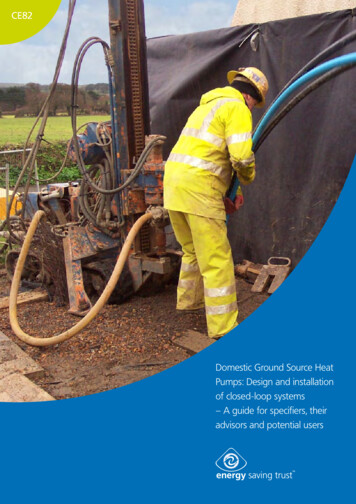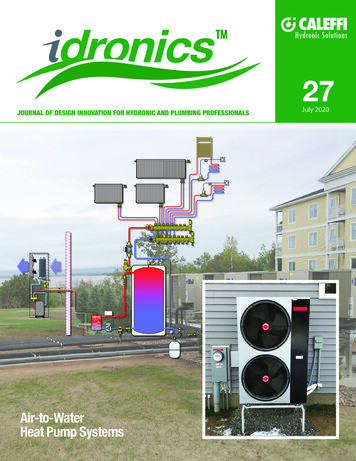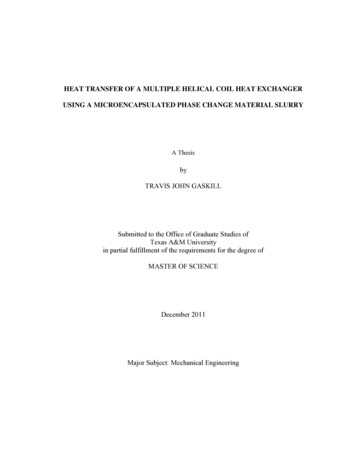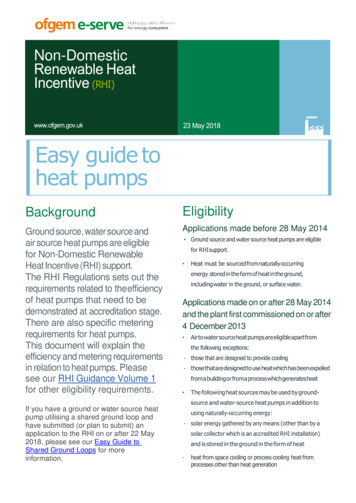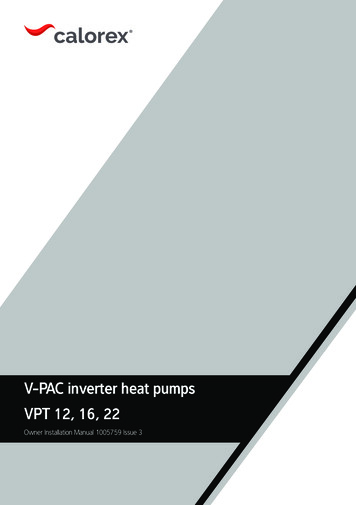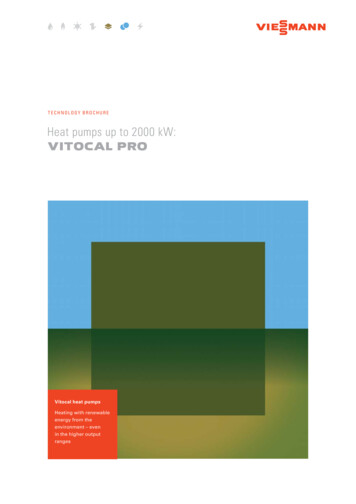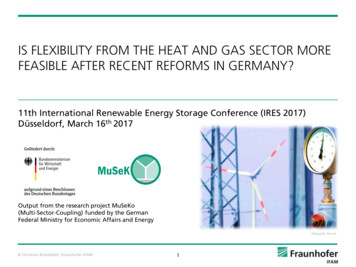
Transcription
IS FLEXIBILITY FROM THE HEAT AND GAS SECTOR MOREFEASIBLE AFTER RECENT REFORMS IN GERMANY?11th International Renewable Energy Storage Conference (IRES 2017)Düsseldorf, March 16th 2017MuSeKOutput from the research project MuSeKo(Multi-Sector-Coupling) funded by the GermanFederal Ministry for Economic Affairs and EnergyBildquelle: faz.net Christine Brandstätt, Fraunhofer IFAM1
AgendaMuSeK1. Flexibility from the Heat and Gas Sector2. Recent Reforms and the German Energy Package3. Energy Modelling with MuGriFlex4. Feasibility of Flexibilities in the Future Christine Brandstätt, Fraunhofer IFAM2
Flexibility from the Heat and Gas Sectorheats toreFlex ibility is the ability to adaptelectricity generation andconsumption to maintain systemstability.heatgrid technical ability givenby several elements suchas CHP, P2H and P2G institutional ability in adecentralized andliberalized systemachieved via regulationand market rulesMuSeKCHPpowergridpowerstoregas powerplantBi-fuelequipmentelectrolysis Do elements that can adapthave incentives to do so?fuel cellvehicleselectricvehiclestransport Christine Brandstätt, Fraunhofer IFAMgasgrid3gass tore
Recent Reforms and the German Energy Package MuSeKrecent regulatory reforms comprise (among other aspects):long expected reform of the subsidy system for CHP, new electricity subsidy for some plants, tendering for others investment subsidy levels for heat networks, stores, etc. special conditions for P2H in “network expansion areas” changes to the surcharges on electricity prices reductions only for consumption exceeding 1 GWh/year (general increase in surcharges) reform of the exceptions from surcharges (large consumers, self supply) Christine Brandstätt, Fraunhofer IFAM4
Spot prices, surcharges and subsidies over time25P2HMuSeKP2GCHP201513,45 14,6311,0810,62 10,73108,00surcharges / subsidiesspot pricespot maxspot min-20-25 Christine Brandstätt, Fraunhofer IFAM52,902,902016 (large)-151,804,272016 (small)-104,272012 (large)2,322,902012 012ct / kWh5,413,10
Modelling with MuGriFlexMuSeK hourly simulation of flexibility options based on heat demands aswell as markets, incentives and regulation Christine Brandstätt, Fraunhofer IFAM6
Example operation schedule in MuGriFlexMuSeK12.0007,00electricity priceheat demand6,00Heat capacity [kW]5,008.0004,006.0003,00store (in)4.0002,00gas boiler1,002.000CHPelectricboiler00,00-1,00 deploys the cheapest supply optionalso considering storage capacity and ramping Christine Brandstätt, Fraunhofer IFAMstore (out)7electricity price [ct/kWh]10.000
Modellinputs: plant parametersplantelectric boilerheat pumpCHP plantPEM electrolyserAL electroly s erSO electroly s ergas boilerheat storeheat networkparameterthermal power outputCOPinvestment costthermal power outputCOPinvestment costthermal power outputElectrical power outputinvestment costthermal power outputefficiency (today/future)thermal power outputefficiency (today/future)thermal power outputefficiency (today/future)thermal power outputthermal power outputinvestment costheat demandthermal peak loadMuSeKunitsmall systemlarge systemkWthkWth1000 kWthkWth1000 kWthkWel1000 kWth%kWth%kWth%kWthkWhth1000 81.5005.0005.0733.3322.00054 / 702.00067 / 702.00077 / 771005.00019235100 heat network with CHP plant, gas boiler and store combined with electric boiler, heat pump or electrolyser Christine Brandstätt, Fraunhofer IFAM820.00030.00057546.17520.000
flexible CHP slightly more feasibleMuSeK slightly higher utilization for CHP in combination with storageunder the new subsidy scheme, even with lower spot pricesutilization (full load hours 0152016utilization large CHP (old scheme)utilization large CHP (new scheme)utilization small CHP (old scheme)utilization small CHP (new scheme) Christine Brandstätt, Fraunhofer IFAM9
flexible CHP slightly more feasibleMuSeK slightly better pay-back times for CHP in combination with storageunder the new subsidy scheme, even with lower spot prices25pay -back (y ears )2015105020122013201420152016pay-back large CHP (old scheme)pay-back large CHP (new scheme)pay-back small CHP (old scheme)pay-back small CHP (new scheme) Christine Brandstätt, Fraunhofer IFAM10
P2H still not viable from spot marketMuSeKprices 2012, v ary ing s urchargescons is tent y ear & s urchargesutilization(full load hours) very low utilization of P2Hbased on regular marketin all years201510520utilization(full load hours)0small P2H1520122013201420152016large P2H2 effect of varying surchargesrather low, main influencefrom electricity prices105020122013 Christine Brandstätt, Fraunhofer IFAM20142015201611
P2G still way to goMuSeK506.00040PEM 2012AEL 2012SOEC 2012PEM futureAEL futureSOEC futurePEM 2012AEL 2012SOEC 2012PEM futureAEL futureSOEC future2.000--302010---10-8-6-4-2024Surcharges (resp. subsidies) [ct/kWh] Christine Brandstätt, Fraunhofer IFAM126810pay-back [a]h (full load)10.000
Summary / ConclusionsMuSeK subsidy levels and surcharges influnce the prices to procure electricity for doenward flexibility or sell electricity as upward flexibility CHP with storage somewhat more feasible than before,particularly larger plant sizes flexibility from P2H and P2G with changed surcharges still not feasiblefrom the regular market, business cases in balancing markets (but declining) self-supply setup may benefit from larger reforms of surcharges (e.g. network charges)in the future Christine Brandstätt, Fraunhofer IFAM13
MuSeKTHANK YOU FOR YOUR TIME AND ATTENTION.Please, feel free to ask questions.Christine Brandstätt M.Sc.Dipl.-Ing. Max FetteFraunhofer IFAMEnergiesystemanalyseFraunhofer .fraunhofer.de 49 (0) 421 2246 – 7027 Christine Brandstätt, Fraunhofer IFAM14max.fette@ifam.fraunhofer.de 49 (0) 421 2246 – 7019
storegrid ower store gas B gas power plant heat store CHP electrolysis i-fuel equipment vehicles fuel cell vehicles transport. Christine Brandstätt, Fraunhofer IFAM 4 MuSeK Recent Reforms and the German Energy Package recent regulatory reforms comprise (among other aspects):





